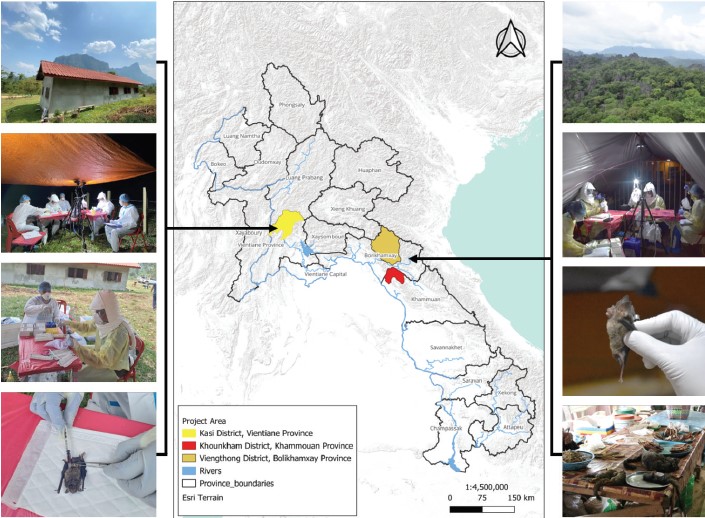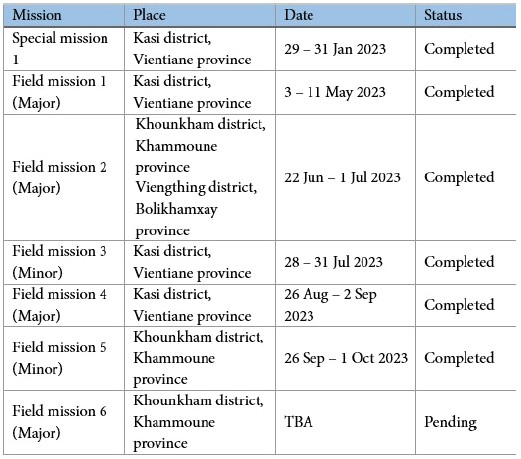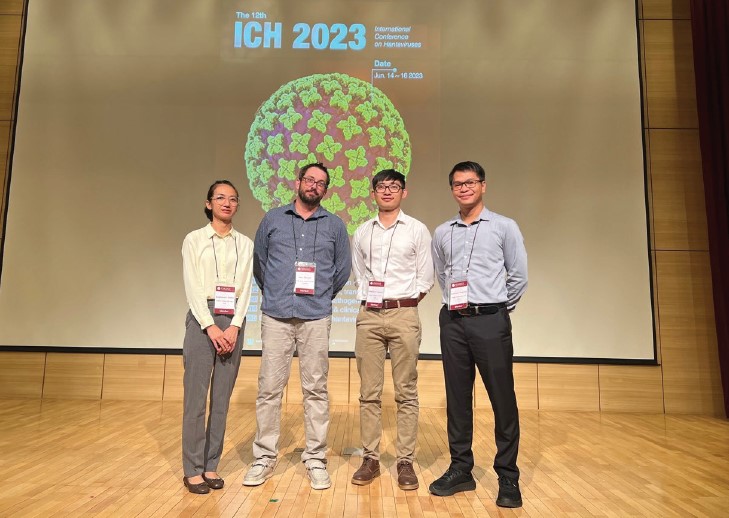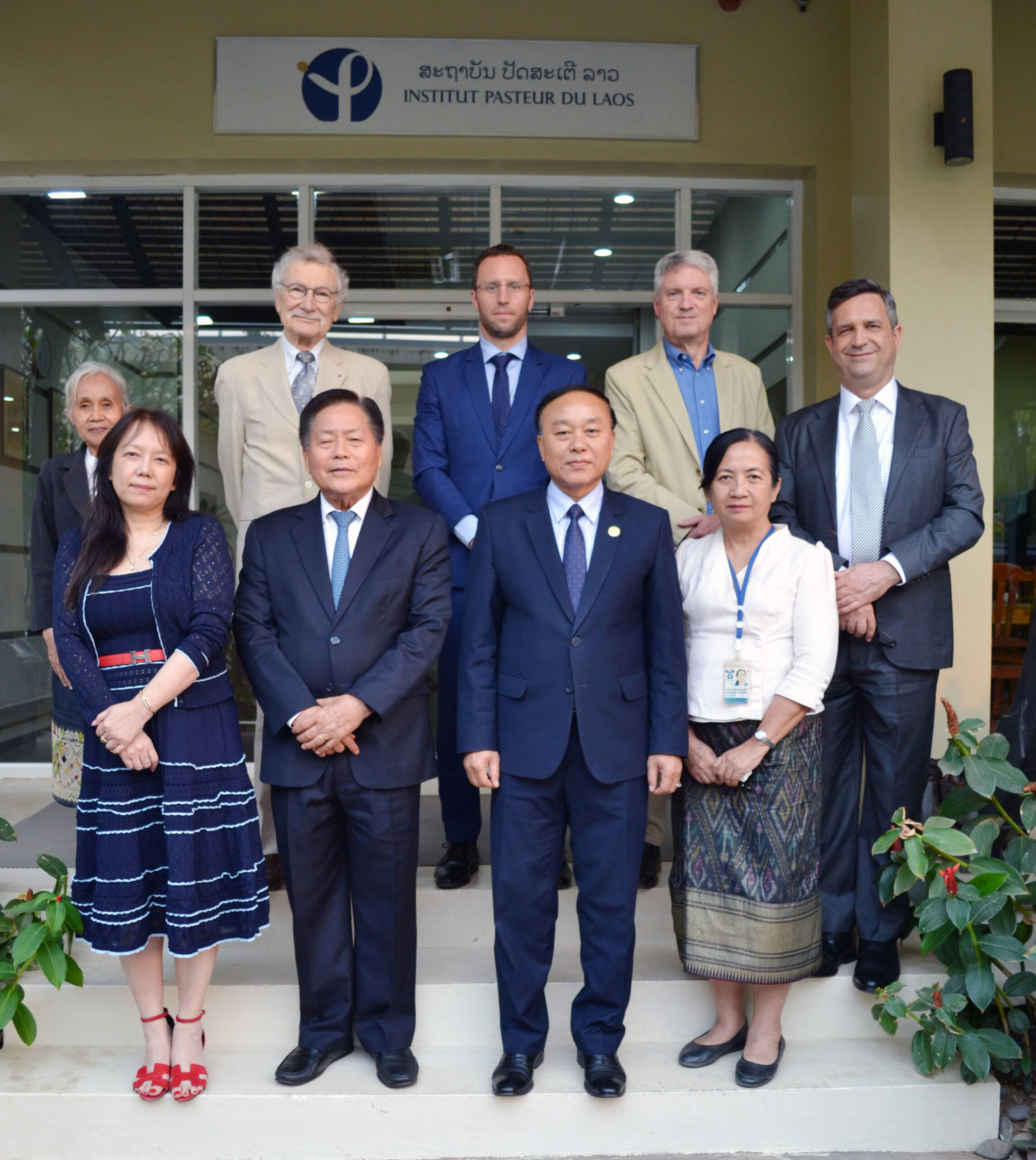Reinforced Collaboration for the Investigation and Response to Emerging Viral Pathogens of Security Concern

Collaborations
National Microbiology Laboratory Branch (NMLB), Canada.
Faculty of Environmental Sciences, National University of Laos, Lao PDR.
National Animal Health Laboratory, Ministry of Agriculture and Forestry, Lao PDR.
Funding
Weapons Threat Reduction Program (WTRP) of Global Affairs Canada, Canada.
Objectives
The main objective of this project is to build and enhance sustainable local capacity in Laos to conduct scientific research on putative emerging viral pathogens with the highest level of biosafety and biosecurity. The project aims to accomplish the following expected results: 1) Enhanced capacity in Laos to monitor for, rapidly detect and effectively respond to disease events involving especially dangerous pathogens of bioterrorism and bioweapons concern; 2) Increased knowledge and awareness among local scientists/community on zoonotic viral pathogens and their safe acquisition, handling, storage and catalog of biological samples; 3) Increased biosafety and biosecurity skills, awareness and application at IPL through the creation of a dedicated biosafety office; 4) Strengthened detection, diagnosis, science and response to emerging viral pathogens by Lao.
Background
Over the last decades, several emerging viral diseases have emerged including Severe Acute Respiratory Syndrome (SARS), H5N1avian influenza, Nipah, and Covid-19. These viruses are believed to have originated in animals before being transmitted to humans, either directly or through an intermediate host.
Laos, a landlocked country in Southeast Asia, is situated in a region recognized as a hotspot for emerging infectious diseases (EIDs) (Jones K.E., et al. 2008). However, Laos currently lacks a robust EIDs surveillance system and has limited laboratory capacity for the rapid detection of novel emerging viral pathogens. Consequently, it is imperative to establish and reinforce the local capabilities for the safe investigation and response to emerging zoonotic viral diseases.
The project, “Reinforced Collaboration for the Investigation and Response to Emerging Viral Pathogens of Security Concern,” is a scientific collaborative effort between the Institut Pasteur du Laos (IPL) and the National Microbiology Laboratory (NML) in Canada, funded by Global Affairs Canada (GAC). Following the completion of the initial pilot phase, the project is dedicated to further enhancing sustainable local capacities in Laos for the safe investigation and response to emerging viral pathogens with pandemic potential, thus ensuring biological threat reduction and strengthening the scientific cooperation between Canada and Laos.
To implement this “One Health” approach, IPL, representing the human health sector, has established collaborative partnerships with local entities in both the animal and environmental sectors, including the Faculty of Environmental Sciences (FES) at the National University of Laos and the National Animal Health Laboratory (NAHL) under the Ministry of Agriculture and Forestry (Figure 1). These multi-sectoral partnerships play a vital role in ensuring the widespread delivery of positive changes in capacity and performance, practices, or behavior to a wide range of intermediaries and beneficiaries.
Figure 1: Collaboration diagram.

Methodology and results
Biosafety and biosecurity
To establish the biosafety and biosecurity office at IPL, a biosafety and biosecurity officer (BSO) was recruited and appointed. While extensive training for IPL’s BSO is currently underway, several actions and training sessions have been conducted to enhance the knowledge and skills of IPL staff and local partners in biosafety and biosecurity.
Figure 2: examples of activities related to biosafety/biosecurity.

Local capacity building.
IPL collaborated with colleagues from NMLB to review and enhance the biosafety levels and work efficiency of various Standard Operating Procedures (SOPs). These included field collection campaigns, nucleic acid extraction of samples, and the pan-coronavirus screening assay. Additionally, we created new SOPs to expand the laboratory capacity for screening assays, including pan-filovirus, pan-paramyxovirus, and pan-hantavirus optimized screening assays.
Several on-site visits were conducted to enhance the capacity of Lao scientists and researchers. This included three NMLB visits to IPL, covering various topics such as the revision of existing SOPs, observation of fieldwork, on-the-job training on sequencing and bioinformatics, and necropsy. Scientists and researchers from Laos also visited Canada to attend a conference and receive training on biosafety/biosecurity as well as bat taxonomy (Figure 3).
Figure 3: Training and mentoring activities

Field missions
The field missions for the year 2023 have been conducted in 2 main sites. The first site is located in the Kasi district of Vientiane province, while the second covers the Khounkham district in Khammoune province and the Viengthong district in Bolikhamxay province (Figure 4).
Figure 4: Map of field mission sites.

IPL conducted 4 major missions and 2 minor missions. The major missions involved three groups: the “bat team”, the “rodent team”, and the “market team”. However, only the “bat team” was involved in the minor field missions (Table 1).
Table 1: Detailed information on field missions.

During the various field missions, the team successfully collected a total of 3,617 biological samples. These samples included anal, saliva, and urine swabs, arthropod ectoparasites, as well as blood and tissues obtained from bats, rodents, and small mammals. The collection methods involved both live-capture techniques and surveys conducted at local wet markets. Additionally, bat guano was collected from the cotton bags and Harp trap’s bags used for capturing bats (Table 2).
Regarding the animal hosts, a total of 1610 bats and 26 rodents were captured during the field missions. In addition, the local market survey observed 187 wildlife animals (Table 3).
Table 3: Aggregated data for inventory of animals

Table 2: Aggregated data for the inventory of collected biological specimens.

Laboratory activities
Currently, laboratory testing of the collected biological samples is in progress. The approach is primarily utilizing PCR-based screening assays. Preliminary results have shown several positive hits of the targeted viral pathogens of interest. IPL and NML have agreed to focus on two distinct groups of viruses for their targeted viral screenings. IPL’s target PCR screenings include Pan-Coronaviruses, Pan-Hantaviruses, Low-GC Pan-Poxviruses, and Pan-Flaviviruses. On the other hand, NML’s targeted viral screenings encompass Old-World Arenaviridae, Filoviruses A/B, Pan-Nairoviruses, and Pan-Paramyxoviruses.
Conclusion and perspectives
The primary focus of the project in its first year is to enhance the knowledge and awareness of local Lao scientists and researchers regarding biosafety and biosecurity. The appointment of the Biosafety and Biosecurity Officer (BSO) at IPL represents a significant milestone for the project. Furthermore, several training sessions and mentoring activities were conducted to elevate the knowledge and skills of local scientists, enabling them to investigate and respond to the viral pathogens with potential pandemic.
At present, laboratory testing has been conducted to screen the biological samples collected during the field missions for pathogens of interest. While the initial results have revealed the presence of several positive samples, further in-depth investigations, such as serological testing, next-generation sequencing, and viral characterization, will be required to gain a comprehensive understanding of these putative viral pathogens. These additional analyses will be instrumental in advancing our knowledge and preparedness for addressing future emerging viral threats.
References
Jones, K. E., Patel, N. G., Levy, M. A., Storeygard, A., Balk, D., Gittleman, J. L., & Daszak, P. (2008). Global trends in emerging infectious diseases. Nature, 451(7181), 990-993.
Congress
Oral presentations
The 1st 2023 mitigation of biological threats (MBT) program coordination meeting 1 – 3 March 2023, Bangkok, Thailand.
World Wildlife Day, 3 March 2023, Vientiane, Laos.
Congress attendance
12th International Conference on Hantaviruses (ICH) in Seoul, Republic of Korea, June 14-16, 2023.
The North American Society for Bat Research (NASBR) meeting 2023 in Winnipeg, Canada, 11-14 October 2023.
Teaching activities
Lecture for the 4th Annual Field Course in Conservation Biology & Global Health at the National University of Laos, 19 October 2023.
Training activities
Training given by the team
Biosafety/biosecurity refreshing training for NAHL.
Training undertaken by the team
Training on sequencing and bioinformatics, March 2023 Capacity building on necropsy, IPL, Laos, 23 – 26 Oct 2023.
Training in the International Microbiology Laboratory, Winnipeg, Canada, 16 – 27 October 2023.

12th International Conference on Hantaviruses (ICH) in Seoul, Republic of Korea.







